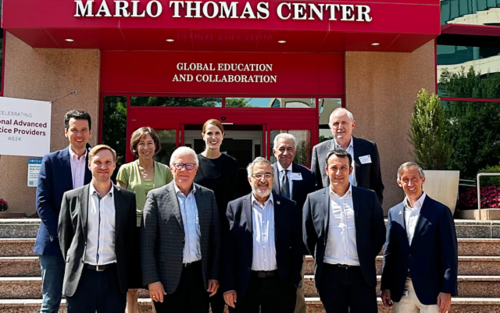St. Jude Family of Websites
Explore our cutting edge research, world-class patient care, career opportunities and more.
St. Jude Children's Research Hospital Home

- Fundraising
St. Jude Family of Websites
Explore our cutting edge research, world-class patient care, career opportunities and more.
St. Jude Children's Research Hospital Home

- Fundraising
Consortium on leukemia in children with Down syndrome offers energy and optimism

Trisomy 21 is felt throughout the genome. Due to this genomic chain reaction, mutations that can lead to leukemia have a higher chance of occurring together in children with Down syndrome. Artwork by Leena Xaypanya
When two or more conditions coincide, referred to as comorbidity, they can be frustratingly difficult to investigate. Often, the two conditions interact, creating a web of cause and effect that is challenging to untangle. The complexity rises when considering groups of the population so often overlooked in the study of disease: individuals with Down syndrome.
It is well known that trisomy 21 (the presence of an extra chromosome 21), the hallmark cause of Down syndrome, brings many health problems. However, the layers of intricacy that Down syndrome adds to clinical investigations mean that investigators are still putting the pieces together to understand the true scope of the condition.
Understanding the scope of Down syndrome and leukemia
It has been noted for decades that children with Down syndrome have an increased risk of developing both of the common types of childhood leukemia, acute lymphoblastic leukemia (ALL) and acute myeloid leukemia (AML). Current statistics put the risk of developing ALL at 20-fold higher and the risk of AML at 150-fold higher in children with Down syndrome compared to children without Down syndrome.
The striking effect that trisomy 21 has on the frequency and characteristics of AML has prompted the World Health Organization to independently label the ailment as myeloid leukemia associated with Down syndrome (ML-DS). ML-DS is characterized by a noticeably good outcome of approximately 90% event-free survival when the disease first presents itself. However, due to the lack of curative treatments for relapsed ML-DS, if the disease comes back, outcomes are dire.
For children with Down syndrome who contract ALL, outcomes are significantly worse than in children who do not have Down syndrome. This is despite ALL having very similar genetic profiles between those who do and do not have Down syndrome.
John Crispino, PhD, MBA, St. Jude Experimental Hematology director, and his colleagues across the globe recognized that there is much work to be done to better understand and treat these patients.
A group with a shared mission
The connective tissue that steered the Symposium on Leukemia in Children with Down Syndrome, the second iteration of which was recently held at St. Jude Children’s Research Hospital, was not just urgency but also collaborative and optimistic hope; hope that by coming together as a community, researchers can advance research and clinical care of leukemia in Down syndrome and share optimism for how far the field has already come.

Speakers at the Symposium on Leukemia in Children with Down syndrome, held recently at St. Jude Children’s Research Hospital. (L to R) Back Row – Elvin Wagenblast, PhD, Karen Rabin, MD, PhD, Sarah Tasian, MD, Jeffery Taub, MD, Hans Hitzler, MD. Front Row - Jan-Henning Klusmann, MD, John Dick, PhD, Shai Izraeli, MD, Sébastien Malinge, PhD, and John Crispino, PhD, MBA.
“The goal of the consortium is to identify the factors that cause progression to acute leukemia and to understand what promotes the relapse,” said Crispino, who hosted the symposium at St. Jude. “We need to know more about the genetics and biology first. Then we can develop new therapies to treat relapsed ML-DS and ALL.” Crispino is the driving force behind the consortium and a leading researcher of leukemogenesis in children with Down syndrome. Addressing his colleagues, he emphasized the importance of understanding the biological root cause for the disparities in outcomes in this disease.
Infants born with Down syndrome have a 30% chance of having a mutation in some of their blood cells that is associated with a condition called transient abnormal myelopoiesis (TAM) — also often called pre-leukemia. “It’s transient because it disappears spontaneously in most cases, usually within a few months of life,” Crispino explained. “But it’s seen as pre-leukemia because children with TAM have a 10 to 20 percent chance of getting acute leukemia within the next four years.”
The GATA1 smoking gun
Trisomy 21 is a catalyst for changes in gene expression across the whole genome. In 2002 and 2003, seminal papers were published in Nature Genetics and Blood wherein Crispino and his colleagues pointed to the gene GATA1 as the telltale outlier linking trisomy-21 with TAM and ML-DS.
Research from Crispino and colleagues into this gene and its function in hematopoiesis (development of blood cells) was the link Down syndrome researchers were searching for, appearing mutated in every infant with Down syndrome who presented with TAM and ML-DS. “Several investigators were sitting on tissue bank myeloid leukemia samples from infants with Down syndrome and were wondering what was wrong genetically,” Crispino explained. “As soon as we published this paper, they looked within their collection and also found GATA1 mutations.”
GATA1 is located on the X chromosome, meaning males have one copy, while females have two. While researchers know that mutations in GATA1 are the trigger for TAM, they are unsure as to why.
“Our hypothesis is trisomy 21 creates a certain gene expression program in hematopoietic progenitor cells [pre-blood cells],” explained Crispino. “That setting then allows GATA1 mutations either to occur at a high frequency or to have a very strong competitive advantage.”
The strength of international collaboration
While research over the past 25 years has culminated in many advancements, this consortium of scientists and clinicians is determined to address the biology, the future of care and the outcomes associated with leukemia in children with Down syndrome.
Jeffery Taub, MD, Endowed Chair in Pediatric Cancer Research at Wayne University and Chief of Oncology at Children’s Hospital of Michigan, has been Crispino’s long-time colleague and friend and firmly believes in the consortium’s potential. “This group is quite remarkable because it brings together international leaders who have studied children with Down syndrome both clinically and through research,” said Taub.
“As pediatricians, it’s so very important because not only are they part of our patient population, but they are particularly vulnerable children. It’s key that we devote attention to providing state-of-the-art care for them.”
The advancement in genomics techniques has opened the door for huge leaps in our understanding of leukemia in children with Down syndrome. Research published in Blood in 2023 from Jun J. Yang, PhD, St. Jude Department of Pharmacy and Pharmaceutical Sciences demonstrated this by characterizing the entire genomic landscape of 295 ALL cases in patients with Down syndrome using whole genome and RNA sequencing. From this work, they identified 15 distinct subtypes of the disease, the first step in understanding the most effective strategies for treatment.
The work was jointly supervised by Karen Rabin, MD, PhD, Department of Pediatrics, Baylor College of Medicine, who acknowledges the shared optimism in the consortium about the future of leukemia treatment in children with Down syndrome. “[This research] gives insight into specific pathways that can be targeted, which may provide a less toxic and more effective way of treating certain genetic subtypes,” Rabin explained. “It can also inform us which subtypes have better outcomes and can benefit from less intensive therapy, and which subtypes have poor outcomes and really need intensive therapy.”
Improving the lives of vulnerable children
Rabin and Yang’s work was supported in no small part by the Gabriella Miller Kids First Pediatric Research Program. As described by its founding body, the National Institutes for Health (NIH), this initiative was set up to “help researchers uncover new insights into the biology of childhood cancer and structural birth defects, including the discovery of shared genetic pathways between these disorders.” Alongside this program is the INCLUDE (INvestigation of Co-occurring conditions across the Lifespan to Understand Down syndromE) Project, an NIH research initiative focused on the critical health and quality-of-life needs of individuals with Down syndrome. Such funding bodies are paving the way for research in Down syndrome blood disease.
The group’s energy as they met, shared findings and discussed implications was optimistic. Several factors drive such international collaborations. The first is engaged and energized research, present in spades from clinical researchers such as Rabin. The second is expertise and applied knowledge from field leaders, such as that provided by Taub and Crispino. The final factor is the support of funding agencies, which are pivotal to ensuring that the most vulnerable populations are not overlooked in ongoing research. Programs such as the Gabriella Miller Kids First Pediatric Research Program, the National Cancer Institute, and the INCLUDE Project offer researchers the full scope of access to truly understand the causative links between Down syndrome and leukemia.
These factors were combined at St. Jude during the symposium and demonstrated that for children born with Down syndrome, the outlook can be bright.






